An official website of the United States government
 United States Department of Labor
United States Department of Labor
Maintain order and protect life and property by enforcing local, tribal, state, or federal laws and ordinances. Perform a combination of the following duties: patrol a specific area; direct traffic; issue traffic summonses; investigate accidents; apprehend and arrest suspects, or serve legal processes of courts. Includes police officers working at educational institutions.
Employment estimate and mean wage estimates for this occupation:
| Employment (1) | Employment RSE (3) |
Mean hourly wage |
Mean annual wage (2) |
Wage RSE (3) |
|---|---|---|---|---|
| 665,280 | 0.5 % | $32.50 | $67,600 | 0.7 % |
Percentile wage estimates for this occupation:
| Percentile | 10% | 25% | 50% (Median) |
75% | 90% |
|---|---|---|---|---|---|
| Hourly Wage | $17.77 | $22.69 | $30.36 | $40.60 | $50.59 |
| Annual Wage (2) | $36,960 | $47,190 | $63,150 | $84,440 | $105,230 |
Industries with the highest published employment and wages for this occupation are provided. For a list of all industries with employment in this occupation, see the Create Customized Tables function.
Industries with the highest levels of employment in this occupation:
| Industry | Employment (1) | Percent of industry employment | Hourly mean wage | Annual mean wage (2) |
|---|---|---|---|---|
| Local Government, excluding schools and hospitals (OES Designation) | 565,300 | 10.20 | $32.44 | $67,480 |
| State Government, excluding schools and hospitals (OES Designation) | 61,130 | 2.81 | $36.11 | $75,110 |
| Colleges, Universities, and Professional Schools | 15,160 | 0.49 | $27.87 | $57,980 |
| Federal Executive Branch (OES Designation) | 12,490 | 0.62 | $27.97 | $58,180 |
| Elementary and Secondary Schools | 5,100 | 0.06 | $26.96 | $56,070 |
Industries with the highest concentration of employment in this occupation:
| Industry | Employment (1) | Percent of industry employment | Hourly mean wage | Annual mean wage (2) |
|---|---|---|---|---|
| Local Government, excluding schools and hospitals (OES Designation) | 565,300 | 10.20 | $32.44 | $67,480 |
| State Government, excluding schools and hospitals (OES Designation) | 61,130 | 2.81 | $36.11 | $75,110 |
| Federal Executive Branch (OES Designation) | 12,490 | 0.62 | $27.97 | $58,180 |
| Colleges, Universities, and Professional Schools | 15,160 | 0.49 | $27.87 | $57,980 |
| Junior Colleges | 3,150 | 0.44 | $26.84 | $55,820 |
Top paying industries for this occupation:
| Industry | Employment (1) | Percent of industry employment | Hourly mean wage | Annual mean wage (2) |
|---|---|---|---|---|
| State Government, excluding schools and hospitals (OES Designation) | 61,130 | 2.81 | $36.11 | $75,110 |
| Local Government, excluding schools and hospitals (OES Designation) | 565,300 | 10.20 | $32.44 | $67,480 |
| Support Activities for Air Transportation | 140 | 0.06 | $30.74 | $63,940 |
| General Medical and Surgical Hospitals | 1,720 | 0.03 | $29.10 | $60,520 |
| Federal Executive Branch (OES Designation) | 12,490 | 0.62 | $27.97 | $58,180 |
States and areas with the highest published employment, location quotients, and wages for this occupation are provided. For a list of all areas with employment in this occupation, see the Create Customized Tables function.
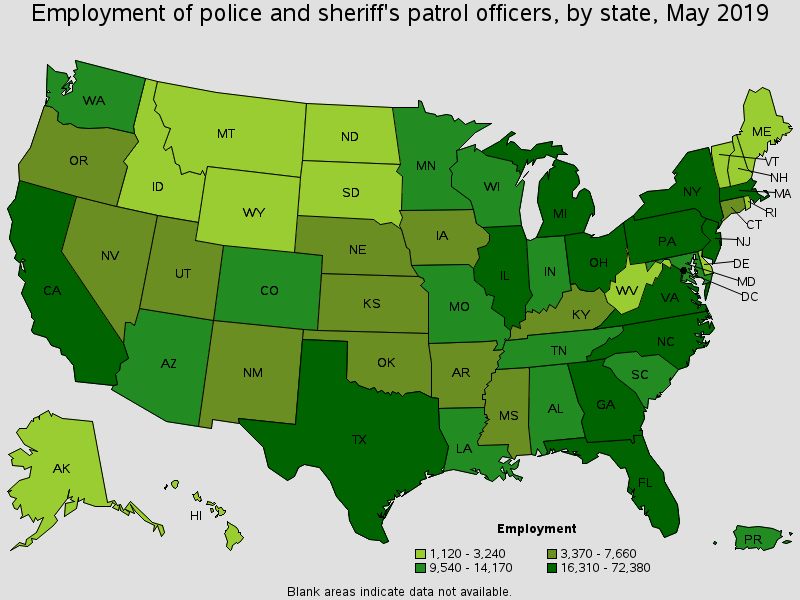
States with the highest employment level in this occupation:
| State | Employment (1) | Employment per thousand jobs | Location quotient (9) | Hourly mean wage | Annual mean wage (2) |
|---|---|---|---|---|---|
| California | 72,380 | 4.16 | 0.92 | $50.58 | $105,220 |
| Texas | 58,840 | 4.73 | 1.05 | $30.65 | $63,740 |
| New York | 55,590 | 5.84 | 1.29 | $37.25 | $77,490 |
| Florida | 39,090 | 4.44 | 0.98 | $29.19 | $60,720 |
| Illinois | 29,460 | 4.89 | 1.08 | $37.67 | $78,350 |
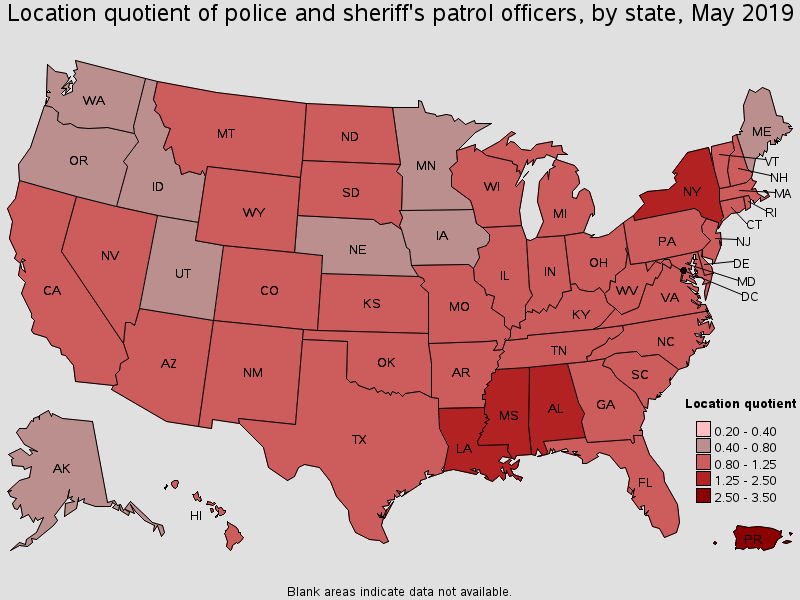
States with the highest concentration of jobs and location quotients in this occupation:
| State | Employment (1) | Employment per thousand jobs | Location quotient (9) | Hourly mean wage | Annual mean wage (2) |
|---|---|---|---|---|---|
| District of Columbia | 5,460 | 7.55 | 1.67 | $36.87 | $76,680 |
| Mississippi | 7,620 | 6.75 | 1.49 | $17.45 | $36,290 |
| Louisiana | 11,420 | 5.94 | 1.31 | $20.42 | $42,470 |
| New York | 55,590 | 5.84 | 1.29 | $37.25 | $77,490 |
| Alabama | 11,410 | 5.78 | 1.28 | $22.36 | $46,510 |
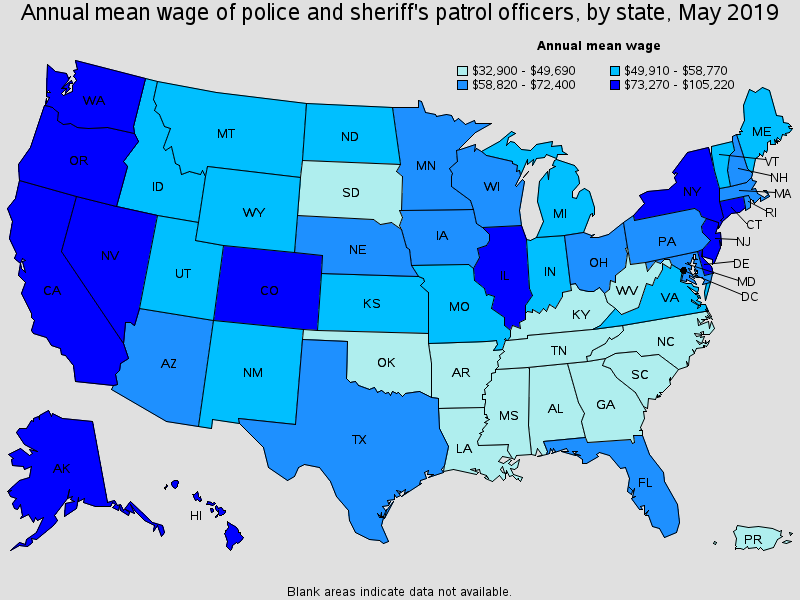
Top paying States for this occupation:
| State | Employment (1) | Employment per thousand jobs | Location quotient (9) | Hourly mean wage | Annual mean wage (2) |
|---|---|---|---|---|---|
| California | 72,380 | 4.16 | 0.92 | $50.58 | $105,220 |
| Alaska | 1,120 | 3.52 | 0.78 | $42.24 | $87,870 |
| New Jersey | 21,840 | 5.34 | 1.18 | $41.75 | $86,840 |
| Washington | 9,540 | 2.87 | 0.63 | $38.56 | $80,200 |
| Hawaii | 2,500 | 3.93 | 0.87 | $37.85 | $78,720 |
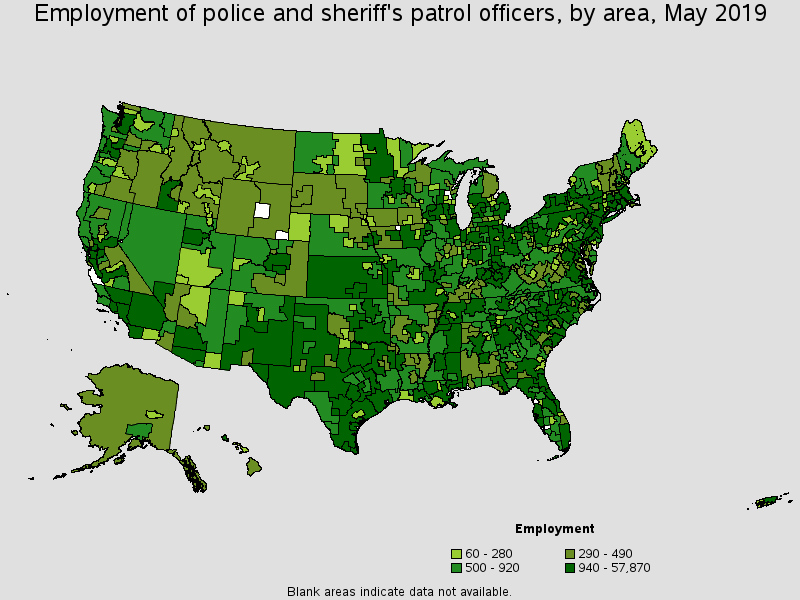
Metropolitan areas with the highest employment level in this occupation:
| Metropolitan area | Employment (1) | Employment per thousand jobs | Location quotient (9) | Hourly mean wage | Annual mean wage (2) |
|---|---|---|---|---|---|
| New York-Newark-Jersey City, NY-NJ-PA | 57,870 | 5.99 | 1.32 | $39.92 | $83,040 |
| Los Angeles-Long Beach-Anaheim, CA | 29,950 | 4.80 | 1.06 | $52.12 | $108,420 |
| Chicago-Naperville-Elgin, IL-IN-WI | 24,190 | 5.17 | 1.14 | $39.51 | $82,170 |
| Washington-Arlington-Alexandria, DC-VA-MD-WV | 16,150 | 5.08 | 1.12 | $35.68 | $74,220 |
| Houston-The Woodlands-Sugar Land, TX | 15,250 | 5.00 | 1.10 | $31.57 | $65,670 |
| Philadelphia-Camden-Wilmington, PA-NJ-DE-MD | 14,570 | 5.06 | 1.12 | $35.58 | $74,010 |
| Dallas-Fort Worth-Arlington, TX | 14,540 | 3.98 | 0.88 | $34.71 | $72,200 |
| Miami-Fort Lauderdale-West Palm Beach, FL | 13,050 | 4.94 | 1.09 | $34.32 | $71,400 |
| Atlanta-Sandy Springs-Roswell, GA | 12,010 | 4.38 | 0.97 | $23.46 | $48,800 |
| Boston-Cambridge-Nashua, MA-NH | 11,700 | 4.18 | 0.92 | $36.18 | $75,250 |
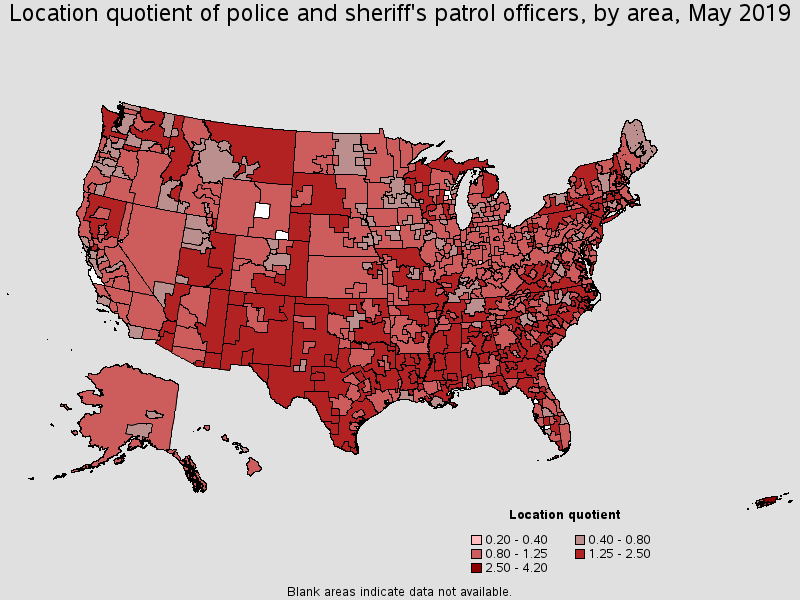
Metropolitan areas with the highest concentration of jobs and location quotients in this occupation:
| Metropolitan area | Employment (1) | Employment per thousand jobs | Location quotient (9) | Hourly mean wage | Annual mean wage (2) |
|---|---|---|---|---|---|
| Ocean City, NJ | 390 | 9.75 | 2.15 | $34.87 | $72,530 |
| Hinesville, GA | 170 | 9.34 | 2.06 | $19.69 | $40,960 |
| New Bern, NC | 390 | 8.91 | 1.97 | $22.75 | $47,330 |
| Shreveport-Bossier City, LA | 1,550 | 8.86 | 1.96 | $21.14 | $43,960 |
| Alexandria, LA | 490 | 8.19 | 1.81 | $18.60 | $38,700 |
| Pine Bluff, AR | 250 | 8.14 | 1.80 | $18.84 | $39,200 |
| Sierra Vista-Douglas, AZ | 260 | 8.10 | 1.79 | $26.36 | $54,820 |
| Laredo, TX | 820 | 7.87 | 1.74 | $31.17 | $64,830 |
| Hattiesburg, MS | 500 | 7.87 | 1.74 | $17.13 | $35,630 |
| Brownsville-Harlingen, TX | 1,090 | 7.83 | 1.73 | $24.45 | $50,850 |
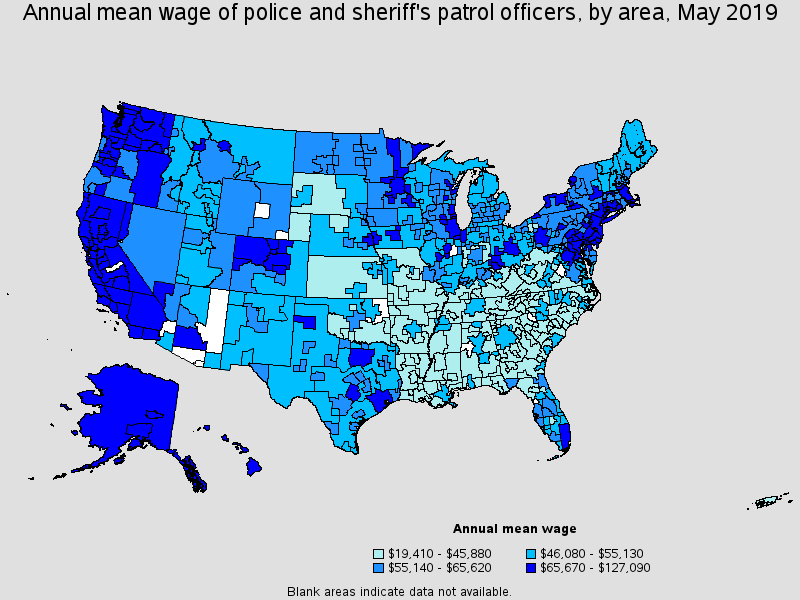
Top paying metropolitan areas for this occupation:
| Metropolitan area | Employment (1) | Employment per thousand jobs | Location quotient (9) | Hourly mean wage | Annual mean wage (2) |
|---|---|---|---|---|---|
| San Jose-Sunnyvale-Santa Clara, CA | 3,870 | 3.40 | 0.75 | $61.10 | $127,090 |
| San Francisco-Oakland-Hayward, CA | 8,580 | 3.47 | 0.77 | $57.33 | $119,260 |
| Vallejo-Fairfield, CA | 1,090 | 7.65 | 1.69 | $55.57 | $115,580 |
| Santa Rosa, CA | 700 | 3.37 | 0.74 | $53.01 | $110,270 |
| Los Angeles-Long Beach-Anaheim, CA | 29,950 | 4.80 | 1.06 | $52.12 | $108,420 |
| Santa Cruz-Watsonville, CA | 330 | 3.34 | 0.74 | $51.92 | $107,980 |
| Oxnard-Thousand Oaks-Ventura, CA | 1,380 | 4.36 | 0.96 | $51.89 | $107,930 |
| Santa Maria-Santa Barbara, CA | 640 | 3.36 | 0.74 | $51.15 | $106,380 |
| Redding, CA | 310 | 4.67 | 1.03 | $49.99 | $103,970 |
| San Luis Obispo-Paso Robles-Arroyo Grande, CA | 530 | 4.52 | 1.00 | $49.38 | $102,710 |
Nonmetropolitan areas with the highest employment in this occupation:
| Nonmetropolitan area | Employment (1) | Employment per thousand jobs | Location quotient (9) | Hourly mean wage | Annual mean wage (2) |
|---|---|---|---|---|---|
| Kansas nonmetropolitan area | 1,900 | 4.83 | 1.07 | $20.09 | $41,780 |
| Southeast Coastal North Carolina nonmetropolitan area | 1,860 | 7.48 | 1.65 | $19.25 | $40,040 |
| Piedmont North Carolina nonmetropolitan area | 1,780 | 6.83 | 1.51 | $20.00 | $41,600 |
| North Northeastern Ohio non-metropolitan area (non-contiguous) | 1,730 | 5.18 | 1.14 | $25.32 | $52,660 |
| North Texas Region of Texas nonmetropolitan area | 1,620 | 5.87 | 1.30 | $22.64 | $47,100 |
Nonmetropolitan areas with the highest concentration of jobs and location quotients in this occupation:
| Nonmetropolitan area | Employment (1) | Employment per thousand jobs | Location quotient (9) | Hourly mean wage | Annual mean wage (2) |
|---|---|---|---|---|---|
| Northeast South Carolina nonmetropolitan area | 960 | 10.09 | 2.23 | $17.65 | $36,710 |
| Northwest Mississippi nonmetropolitan area | 920 | 9.81 | 2.17 | $15.42 | $32,080 |
| Northeast Coastal North Carolina nonmetropolitan area | 920 | 9.80 | 2.16 | $19.99 | $41,580 |
| Northeast Virginia nonmetropolitan area | 470 | 9.44 | 2.08 | $23.30 | $48,470 |
| Southwest Louisiana nonmetropolitan area | 660 | 9.24 | 2.04 | $17.25 | $35,880 |
Top paying nonmetropolitan areas for this occupation:
| Nonmetropolitan area | Employment (1) | Employment per thousand jobs | Location quotient (9) | Hourly mean wage | Annual mean wage (2) |
|---|---|---|---|---|---|
| Eastern Sierra-Mother Lode Region of California nonmetropolitan area | 330 | 5.52 | 1.22 | $45.89 | $95,460 |
| North Valley-Northern Mountains Region of California nonmetropolitan area | 740 | 7.33 | 1.62 | $43.11 | $89,660 |
| Alaska nonmetropolitan area | 460 | 4.20 | 0.93 | $39.64 | $82,450 |
| North Coast Region of California nonmetropolitan area | 570 | 5.34 | 1.18 | $38.37 | $79,810 |
| Hawaii / Kauai nonmetropolitan area | 490 | 4.82 | 1.06 | $37.30 | $77,590 |
These estimates are calculated with data collected from employers in all industry sectors, all metropolitan and nonmetropolitan areas, and all states and the District of Columbia. The top employment and wage figures are provided above. The complete list is available in the downloadable XLS files.
The percentile wage estimate is the value of a wage below which a certain percent of workers fall. The median wage is the 50th percentile wage estimate--50 percent of workers earn less than the median and 50 percent of workers earn more than the median. More about percentile wages.
(1) Estimates for detailed occupations do not sum to the totals because the totals include occupations not shown separately. Estimates do not include self-employed workers.
(2) Annual wages have been calculated by multiplying the hourly mean wage by a "year-round, full-time" hours figure of 2,080 hours; for those occupations where there is not an hourly wage published, the annual wage has been directly calculated from the reported survey data.
(3) The relative standard error (RSE) is a measure of the reliability of a survey statistic. The smaller the relative standard error, the more precise the estimate.
(9) The location quotient is the ratio of the area concentration of occupational employment to the national average concentration. A location quotient greater than one indicates the occupation has a higher share of employment than average, and a location quotient less than one indicates the occupation is less prevalent in the area than average.
Other OES estimates and related information:
May 2019 National Occupational Employment and Wage Estimates
May 2019 State Occupational Employment and Wage Estimates
May 2019 Metropolitan and Nonmetropolitan Area Occupational Employment and Wage Estimates
May 2019 National Industry-Specific Occupational Employment and Wage Estimates
Last Modified Date: July 6, 2020